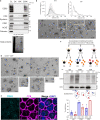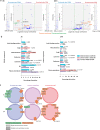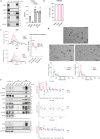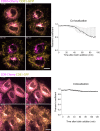Specificities of exosome versus small ectosome secretion revealed by live intracellular tracking of CD63 and CD9
- PMID: 34282141
- PMCID: PMC8289845
- DOI: 10.1038/s41467-021-24384-2
Specificities of exosome versus small ectosome secretion revealed by live intracellular tracking of CD63 and CD9
Abstract
Despite their roles in intercellular communications, the different populations of extracellular vesicles (EVs) and their secretion mechanisms are not fully characterized: how and to what extent EVs form as intraluminal vesicles of endocytic compartments (exosomes), or at the plasma membrane (PM) (ectosomes) remains unclear. Here we follow intracellular trafficking of the EV markers CD9 and CD63 from the endoplasmic reticulum to their residency compartment, respectively PM and late endosomes. We observe transient co-localization at both places, before they finally segregate. CD9 and a mutant CD63 stabilized at the PM are more abundantly released in EVs than CD63. Thus, in HeLa cells, ectosomes are more prominent than exosomes. By comparative proteomic analysis and differential response to neutralization of endosomal pH, we identify a few surface proteins likely specific of either exosomes (LAMP1) or ectosomes (BSG, SLC3A2). Our work sets the path for molecular and functional discrimination of exosomes and small ectosomes in any cell type.
© 2021. The Author(s).
Conflict of interest statement
The authors declare no competing interests.
Figures








References
Publication types
MeSH terms
Substances
Grants and funding
LinkOut - more resources
Full Text Sources
Other Literature Sources
Research Materials
Miscellaneous

